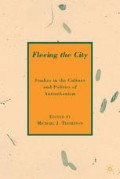Abstract
Antiurbanism takes many forms, economic as well as social, political as well as cultural. One way that antiurbanism—defined perhaps as an opposition to the publicness of the city—has become manifest in the spaces of the city itself is through an overweening concern with safety and security. One ideal of urbanism is precisely that it is there, in the city, that chance, serendipity, the unexpected, has the best chance to flourish, and out of chancy, serendipitous, and unexpected encounters new social, cultural, and political formations might arise. Rarely achieved in practice, this ideal of urbanism is nonetheless critical to contemporary theories of citizenship—as something to be struggled toward.1 Control over city space, practices of safety and security, that is, has never been stronger to the production of urban space; but in recent history (and not just since 9/11) certain practices of security (separating out “strangers,” mechanical and human surveillance, defensive design), have become, in many ways, defining. Discourses of safety have become dominant in discussions of “good” urban space. There is nothing wrong with being concerned with, and seeking to design in relation to, security, especially bodily security, or the safety of urban space users. But, I want to suggest in what follows, that when security and safety are defining, a certain antiurbanism rooted in fear—what I call “social agoraphobia”—comes to be the primary structuring force of urban life.
A different version of this chapter was printed in the proceedings of the 2007 Deutsche Geographentag, Umgang mit Risiken: Katastrophen, Destabilisierung, Sicherheit (Coping with Risk: Catastrophe, Destabilization, Security) (Bayreuth 2007).
Access this chapter
Tax calculation will be finalised at checkout
Purchases are for personal use only
Preview
Unable to display preview. Download preview PDF.
Notes
See, for example, Iris Marian Young, Justice and the Politics of Difference (Princeton: Princeton University Press, 1990)
Kurt Iveson, Publics and the City (Oxford: Blackwell, 2007)
Sophie Watson, City Publics (London: Routledge, 2006).
World Health Organization, ICD-10: Classification of Mental and Behavioural Disorders (Geneva: World Health Organization, 1992).
The following discussion of agoraphobia, and the case study of San Diego, is a revision of an argument made in Don Mitchell, “Frogkt og Konstructions av det Offentlige Rom,” Adbusters Magasin (Norway) 1 (2004): 24–27.
A good overview of the historical geography and political economy of San Diego can be found in Mike Davis and Jim Miller, Under the Perfect Sun: The San Diego Tourists Never See (New York: New Press, 2003)
Miller, Designs on the Public; Stacy Warren, “Disneyfication of the Metropolis: Popular Resistance in Seattle,” Journal of Urban Affairs 16 (1994): 89–107.
Andrew Ross, The Celebration Chronicles: Life, Liberty and the Pursuit of Property Value in Disney’s New Town (New York: Ballentine, 1999).
A. Reevew and R. Simmonds, “‘Public Realm’ as Theatre: Bicester Village and Universal City Walk,” Urban Design International 6 (3-4) (2001): 173–190.
Don Mitchell, The Right to the City: Social Justice and the Fight for Public Space (New York: Guilford, 2003).
Andrew Merrifield, Henri Lefebvre: A Critical Introduction (New York: Routledge, 2006), 14.
Henri Lefebvre, The Urban Revolution (Minneapolis: University of Minnesota Press, 2003).
David Harvey, Paris: The Capital of Modernity (New York: Routledge, 2003).
Hal Rothman, Neon Metropolis: How Las Vegas Started the 21st Century (New York: Routledge, 2003).
Zygmunt Bauman, Liquid Fear (Cambridge: Polity, 2006).
The following discussion of, and all quotations concerning, the Hicks case is derived from Don Mitchell, “Property Rights, the First Amendment, and Judicial Urbanism: The Strange Case of Hicks v. Virginia,” Urban Geography 26 (2006): 565–586.
See, for example, Richard Sennett, Families Against the City (New York: Vintage, 1974)
Author information
Authors and Affiliations
Editor information
Copyright information
© 2009 Michael J. Thompson
About this chapter
Cite this chapter
Mitchell, D. (2009). Against Safety, Against Security: Reinvigorating Urban Life. In: Thompson, M.J. (eds) Fleeing the City. Palgrave Macmillan, New York. https://doi.org/10.1057/9780230101050_11
Download citation
DOI: https://doi.org/10.1057/9780230101050_11
Publisher Name: Palgrave Macmillan, New York
Print ISBN: 978-1-349-37641-4
Online ISBN: 978-0-230-10105-0
eBook Packages: Palgrave Social & Cultural Studies CollectionSocial Sciences (R0)

